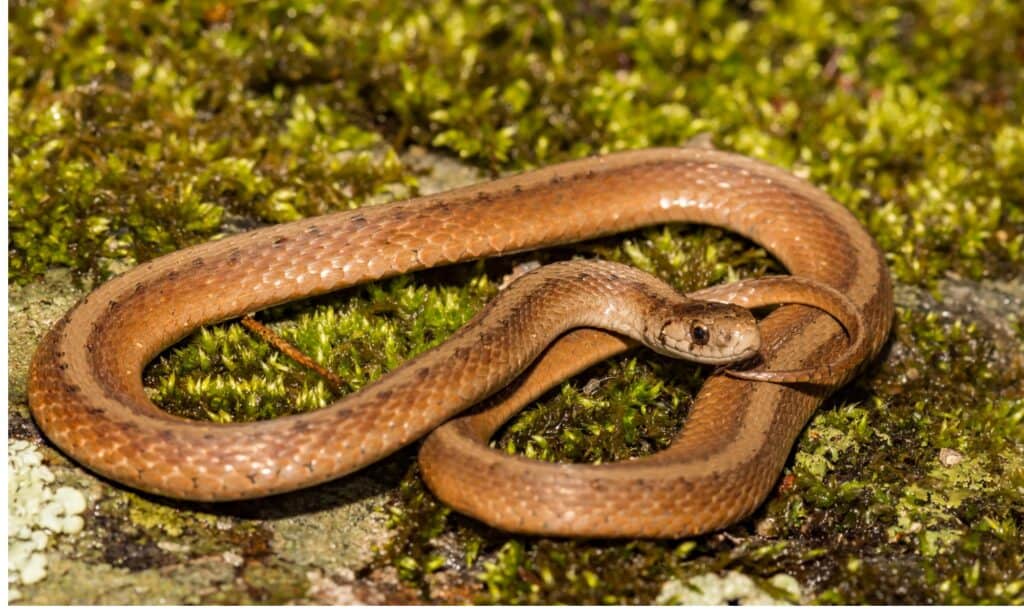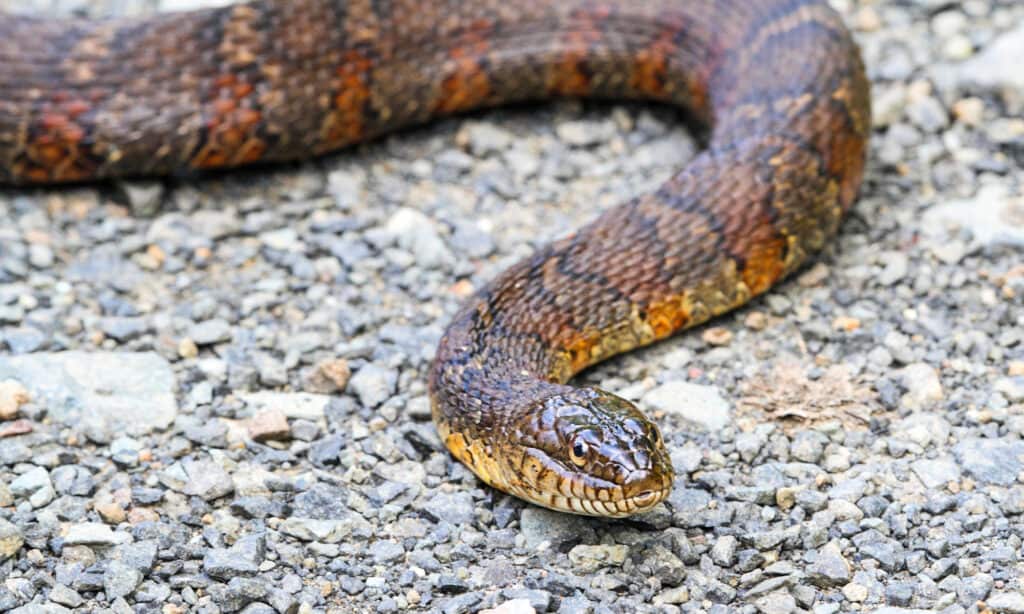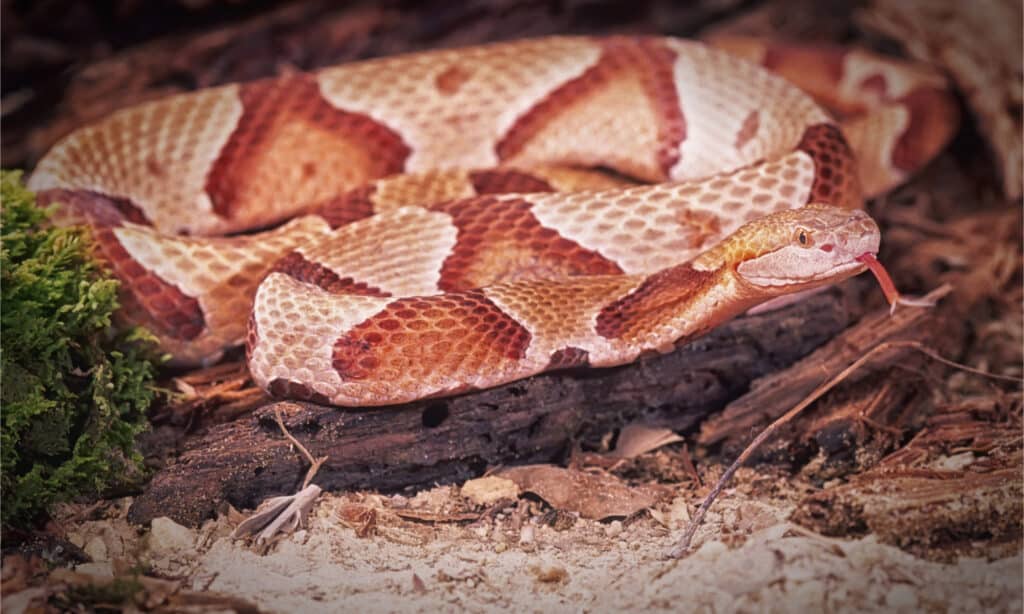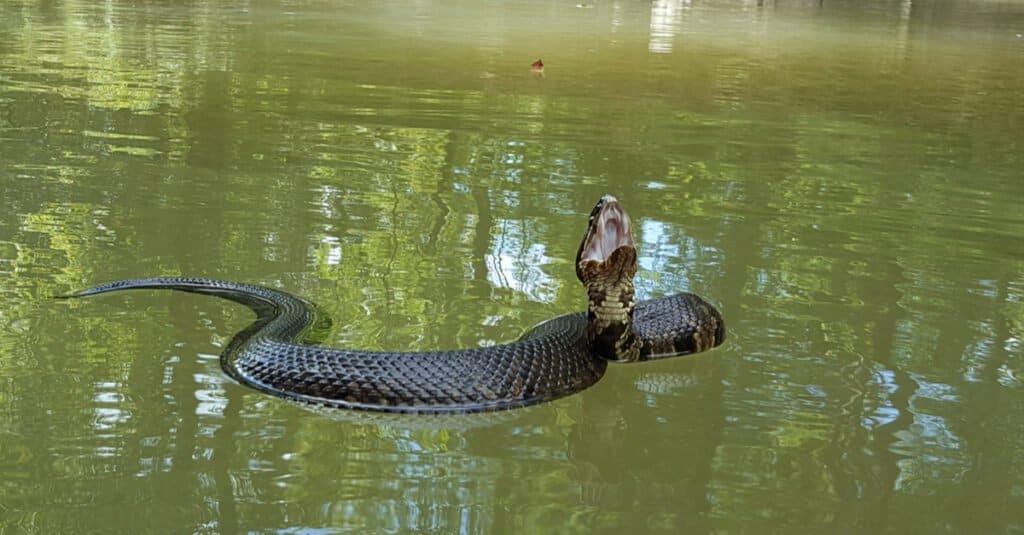Georgia’s climate is terrific for snakes and that makes gardens everywhere in Georgia great for at least some snakes. Because it’s temperate most of the year, they don’t brumate for long. And, although there are lots of commercial and residential developments, many snakes are doing just fine.
The southern state’s climate is so good for snakes that there are 46 species native to Georgia, plus a few introduced species. Of those native snakes, only 6 are dangerous venomous species. As you’ll see, they don’t even make the top five!
We’re starting with the top five snakes you may find in your garden — they’re all nonvenomous.
Because we think knowing how to identify venomous snakes is
#1 Most Common Snake in Georgia Gardens: Dekay’s Brownsnake (Storeria dekayi)

Northern brown snakes are the type species for Storeria dekayi
©iStock.com/JasonOndreicka
Dekay’s brown snake seldom gets bigger than 12 inches. The record was a whopping 19 ¾ inches long. The species doesn’t lay eggs, but instead the babies are born live and ready to go. They share this trait with garter snakes, another natricine snake — a fancy word for snakes in the Natricinae family that includes water snakes like #2 on our list.
Small and slender, Dekay’s brown snakes have small heads and round pupils. They’re sometimes confused for garter snakes because, like garter snakes, Dekay’s brown snakes often have a light-colored dorsal stripe. Their bodies are usually a shade of brown or gray with darker markings on either side of their dorsal stripe.
This tiny species helps keep the slug and earthworm populations under control. Dekay’s brown snake is extremely common in the eastern U.S. This reclusive snake stays hidden under leaf litter, rocks, and logs most of the time — ironically also a great place to find slugs and earthworms. Even little snakes follow their food!
#2 Common Watersnake (Nerodia sipedon)

Common water snakes are sometimes mistaken for venomous cottonmouth snakes.
©Steve Byland/Shutterstock.com
Although the next species on our list probably won’t be in your city garden, it does just fine in Georgia’s country gardens with a water source. They’re not picky about what sort of water source either — it could be a natural stream or your koi pond. Which brings us to their prey — fish, frogs, and other small creatures that live in and around water.
Common watersnakes are well-named. They’re the most common water snake species in the eastern U.S. and range as far north as southern Canada.
A heavy-bodied snake, they’re often confused for water moccasins. But, they’re usually thinner and grow up to four feet , five inches long. the only defense these nonvenomous snakes have is a set of razor-sharp teeth — which they will use against anyone who tries to pick them up.
This species has a flatter head that is the same width as its neck. Like many snakes, common water snakes can flatten their heads out in an effort to look bigger and meaner. However, all they do is look goofy because it stretches their face to cartoonish proportions.
Common water snakes have dark vertical bars along their lip scales and round pupils — something that venomous North American pit vipers lack. They can be gray, reddish, brown or brownish-black with darker neck crossbands and body blotches. As they age, common water snakes darken, hiding their pattern, but their bellies often stay yellow, white, or gray.
#3 Eastern Rat Snake (Pantherophis alleghaniensis)

Large adult Eastern black rat snake in defensive coiled posture on road. The snake has a shiny black body with a checkerboard belly.
©Mike Wilhelm/Shutterstock.com
We love rat snakes. They seem like the comedians of the snake world with their crazy climbing antics! Rat snakes worldwide have inspired their very own Facebook group — Ratsnakes in Predicaments.
The eastern rat snake can grow to six feet long, but the record is seven and a half feet long. They are active most of the day and have absolutely no shame. We would not be surprised to hear you found a rat snake in your Georgia garden! A few have startled people in their kitchens and garages, while other help themselves to chicken eggs.
These long, muscular snakes don’t have the heaviness of a pit viper, but are more substantial than a racer. Adult eastern rat snakes in Georgia gardens are usually solid black with white on their chins. Juveniles have a bold pattern with gray or brown base color and dark rectangular blotches down the backs.
Eastern rat snakes eat anything they can fit in their mouths, but are particularly fond of rodents, baby birds, and eggs. You can find these snakes cruising through attic crawl spaces, trees, fences, and the foundation of houses.
#4 Eastern Garter Snake (Thamnophis sirtalis sirtalis)

One of the most cold-tolerant snakes in the world, garter snakes are usually active early and later in the year than other species.
©Erik Agar/Shutterstock.com
Our next common Georgia garden snake is the eastern garter snake. It’s highly adaptable and can be found in vacant lots, open fields, and your shrubs.
Various garter snakes inhabit most of North America’s snake-friendly climate zones. They’re one of the most cold-tolerant snakes and are often active both earlier and later in the year than other snakes.
Most eastern garter snakes average one and a half to two feet long, but occasionally one will grow to four feet. Like other natricine snakes, they give birth instead of laying eggs and are one of the most cold-adapted snakes in the world.
Although the different subspecies are hard to differentiate, it’s not difficult to see that it’s a garter snake. These snakes have three longitudinal stripes that start right behind their heads — one dorsal and one on each flank. Eastern garter snakes often have yellowish or cream colored stripes and greenish, brown, or black body color.
Harmless to humans, eastern garter snakes’ saliva appears to be toxic to their favorite prey — amphibians.
#5 Racer (Coluber constrictor)

This close-up is of a Blue Racer (Coluber constrictor foxii) — one of the fastest snakes known.
©Psychotic Nature/Shutterstock.com
North American racers are another common snake. Different subspecies inhabit most of the U.S. except for the arid Arizona climate.
These snakes are long and thin, often reaching five feet in overall length. As juveniles, they usually have a light background color with darker splotches over their body. Many people mistake them for young coachwhips and rat snakes because their patterns are so similar.
Racers become solid colored as they mature. Depending on the color, you’ll find different names for them — blue racer, yellow bellied racer, black racer, etc. Their bellies are usually a solid color that ranges from white or cream to black.
If you see a racer in your Georgia garden, it won’t be for long. This species can take off at four miles per hour. While that doesn’t seem very fast, for a snake it’s light speed!
Other Nonvenomous Georgia Garden Snakes
Georgia’s 46 native species are mostly harmless. Some are small enough that people confuse them for worms at first glance!
Here are a few you might find in your garden:
- Ring-necked snake (Diadophis punctatus)
- Red-bellied snake (Storeria occipitomaculata)
- Rough greensnake (Opheodrys aestivus)
- Southern hognose snake (Heterodon simus)
- Scarlet kingsnake (Lampropeltis elapsoides)
- Mudsnake (Farancia abacura)
- Florida crowned snake (Tantilla relicta)
Venomous Snakes in Georgia Gardens
Fortunately, venomous snakes aren’t as common in Georgia gardens — they’re extremely shy and avoid people. All but one is a pit viper and easy to identify as venomous — those giant venom glands make their heads huge. Then, there’s the slightly angry expression thanks to the vertical pupils and ridge over the eyes.
Even though they aren’t as common in your garden, it’s still important to know about them. After all, you wouldn’t go out foraging for mushrooms without first knowing which ones would kill you, would you? It’s the same with handling snakes. Most are safe, but some can injure or kill you.
Copperhead (Agkistrodon contortrix)

Copperheads are beautiful, but venomous! Fortunately, their venom isn’t as dangerous as their cousin the cottonmouth.
©outdoorsman/Shutterstock.com
By far the most common venomous snake in Georgia gardens is the copperhead. It’s far less wary of people than the others and tolerates disturbed and developed habitat much better.
Copperheads are bright and beautiful snakes. They have a light brown to pinkish brown base color with hourglass-shaped markings. When you view them from the side, they look like chocolate kisses. Their heads are copper-colored, which is what gives them their name.
This isn’t a large snake and most of them average between two and three feet long. However, they do have classic pit viper features:
- Heat sensing pits between eye and nostril
- Vertical pupils
- Ridge over the eyes
- Chunky body, proportionately large head, and skinny neck
These snakes love snacking on cicadas in the summer — yes, they climb trees. But most of them stick to the ground, hiding in leaf litter. Copperheads have a varied diet and may eat everything from insects to mice.
Happily, they’re decidedly not aggressive and many people have stepped right next to one and not been bitten. Of course, we don’t recommend it. You never know when you’ll get bitten.
Cottonmouth (Agkistrodon piscivorus, A. conanti, and hybrids)

Cottonmouth swimming in water. The snake has a long, thick, muscular body measuring up to 6 feet in size.
©Seth LaGrange/Shutterstock.com
Water moccasins (also called cottonmouths) are also common in Georgia, but probably not as common in city gardens. They’re incredibly reclusive, and often don’t even brumate with other snakes.
As juveniles, these snakes look a lot like copperheads. The biggest visual difference is that their pattern has jagged edges that many people call pixellated and the very dark stripe that starts behind their eyes. That’s where the similarities end.
Cottonmouths get bigger than copperheads — some grow to four feet long and the record is around six feet long. Additionally, they don’t keep that pattern — they darken with age.
Their name comes from their defensive behavior: when a cottonmouth is faced with a threat, they throw their mouths open and show off the bright white interior.
These snakes prefer eating fish and amphibians, so they stay near water sources. In fact, this is the only semiaquatic pit viper in North America.
Other Venomous Georgia Garden Snakes
The other venomous snakes you might find in your Georgia garden are rare. You’re not likely to see one, but you might — so here they are with links to more information:
- Timber rattlesnake (Crotalus horridus)
- Eastern coral snake (Micrurus fulvius)
- Pygmy rattlesnake (Sistrurus miliarius)
- Eastern diamondback rattlesnake (Crotalus adamanteus)
Most snakes avoid people because we’re a lot bigger and more dangerous to them. They can’t eat us, so that makes us a threat to their safety.
Love them or fear them, give snakes some space and they’ll do the same for you. And, they’ll take care of your pest problems!
The photo featured at the top of this post is © Psychotic Nature/Shutterstock.com
Discover the "Monster" Snake 5X Bigger than an Anaconda
Every day A-Z Animals sends out some of the most incredible facts in the world from our free newsletter. Want to discover the 10 most beautiful snakes in the world, a "snake island" where you're never more than 3 feet from danger, or a "monster" snake 5X larger than an anaconda? Then sign up right now and you'll start receiving our daily newsletter absolutely free.
Thank you for reading! Have some feedback for us? Contact the AZ Animals editorial team.






